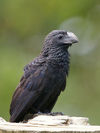Genus Crotophaga
Black ani - This ani is found in open and semi-open country and areas under cultivation. The nest, built communally by several pairs, is a deep cup lined with leaves and placed usually 2–6 m high in a tree. A number of females lay their chalky blue eggs in the nest and then share incubation and feeding.
Greater Ani - This ani is found in mangrove swamps, semi-open woodland near water, and the edges of forests. It is a seasonal migrant in at least some parts of its range. The nest, built communally by several pairs, is a deep cup lined with leaves and placed usually 2-5 m high in a tree. A number of females lay their chalky deep blue eggs in the nest and then share incubation and feeding. Nests have been found containing 3-10 eggs.
San Lucas ani - The Groove-billed Ani is about 34 cm long, and weighs 70-90 g . It is completely black, with a very long tail almost as long as its body. It has a huge bill with horizontal grooves along the length of the upper mandible. It is very similar to the Smooth-billed Ani, some of which have bills as small as the Groove-billed and with grooves on the basal half. The two species are best distinguished by voice and range. In flight, the ani alternates between quick, choppy flaps and short glides.



